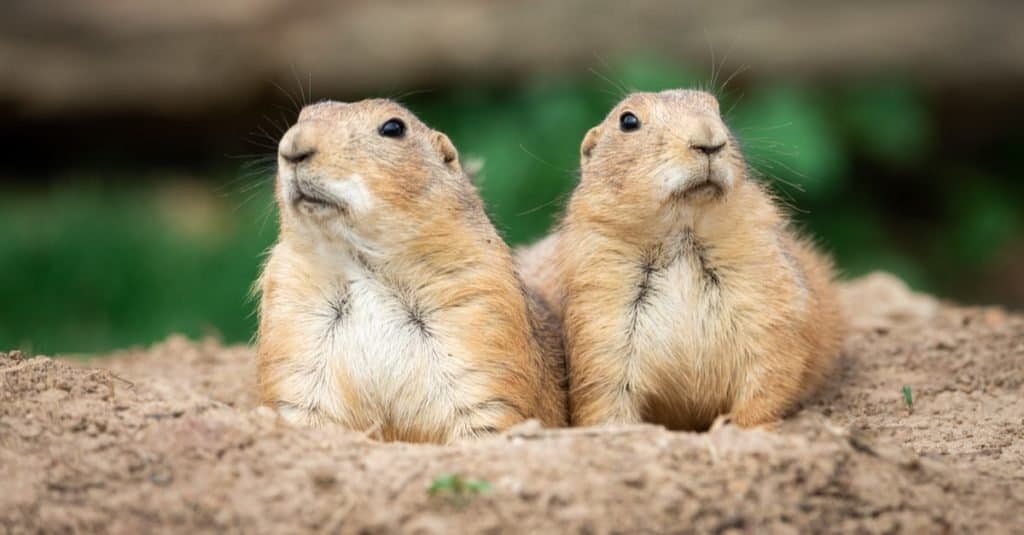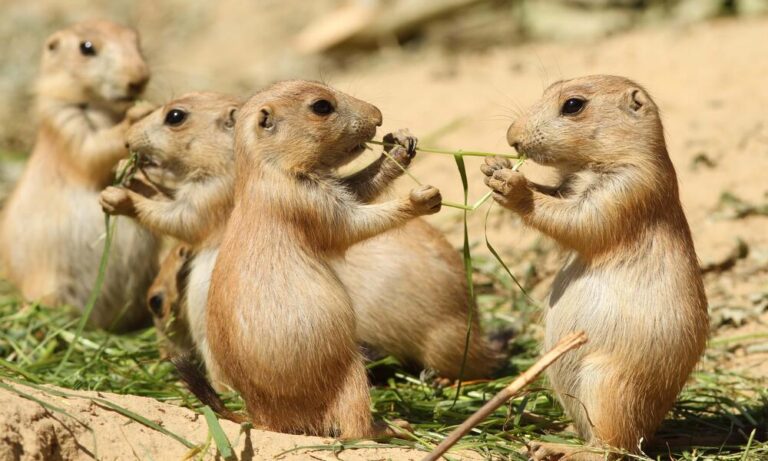Gophers are small burrowing rodents known for their destructive tendencies, while prairie dogs are social animals that dig complex tunnel systems in grasslands.

Credit: a-z-animals.com
Physical Characteristics And Identification
Gophers and prairie dogs are two small burrowing mammals that one can encounter while exploring fields or meadows. Although both belong to the rodent family, they are different creatures altogether. In this section of the blog post, we will compare the physical characteristics of these two animals and discuss how to identify each one.
Physical Differences Between Gophers And Prairie Dogs
Gophers and prairie dogs are very different in terms of their physical characteristics, and it’s important to know how to differentiate between the two species. Here are the key differences:
- Size: Gophers are generally smaller, measuring around 6-8 inches in length, while prairie dogs can grow up to 14-17 inches long.
- Tail: The tail is one of the most noticeable differences between the two species. Gophers have short tail, which is often hidden in their burrows, while prairie dogs have a long, bushy tail that they use to communicate with others and balance while standing upright.
- Ears: Prairie dogs have much larger ears than gophers. Their ears stand out and are easy to see from a distance, while gophers have small ears that are not as noticeable.
- Teeth: Gophers have large teeth that are suitable for digging, while prairie dogs have teeth adapted for chewing tough grasses and plants.
Identifying Features Of Each Species
To identify whether you’re looking at a gopher or a prairie dog, there are a few distinguishing features to keep in mind.
Gophers:
- Gophers are grayish-brown in color and have thick, short fur.
- They have small black eyes and round, chubby cheeks.
- Gophers have short legs and broad feet with large front claws that are perfect for digging.
Prairie dogs:
- Prairie dogs are light brown with a lighter-color belly and dark tips on their tail.
- They have large, alert eyes that always seem to be on the lookout for danger.
- Prairie dogs have more complex social behavior than gophers and are often seen standing upright, using their tails to communicate while standing guard for predators.
While gophers and prairie dogs are similar in their burrowing habits and rodent family, they have distinct physical characteristics that help differentiate between them. If you encounter either species while out in a meadow, keep in mind these spotting features, sizes, and shapes to know at a glance which one you are looking at.
Habitat And Burrowing Habits
Types Of Habitats Gophers And Prairie Dogs Prefer
Gophers and prairie dogs are both burrowing rodents, but their habitats differ. Here are the key points to consider:
- Gophers prefer soil that is loose and well-drained, such as grasslands, orchards, and fields. They dig elaborate tunnel systems that stretch up to 200 meters long and can go as deep as six feet into the ground.
- Prairie dogs live in colonies on grasslands, deserts, and prairies. They prefer dry soil and avoid sticky or heavy clay soils. They dig shorter tunnels than gophers, and their burrows are generally more extensive and complex.
Differences In Burrow Structures And Digging Habits
Although gophers and prairie dogs are similar in many ways, their burrow structures and digging habits are different. Here are the key points to note:
- Gopher burrows are usually solitary and more extensive, and they generally consist of a series of underground tunnels with numerous exit and entrance points. They create mounds of soil when digging these tunnels.
- Prairie dogs typically live in large colonies and, as a result, create interconnected burrow systems. The burrows are shallower, have fewer entrance and exit points, and generally do not lead to mounds of soil.
Gophers prefer loose, well-drained soil and dig extensive burrow systems, while prairie dogs prefer grasslands and deserts and create interconnected colonies. Gophers create numerous mounds of soil due to their extensive burrow systems, while prairie dogs dig shallower tunnels with fewer entrance and exit points.
Diet And Eating Habits
Gophers and prairie dogs are two of the most common rodents in the north american grasslands. They share a lot in common, but they also have some differences. One major difference is their diets and eating habits. In this section, we will compare the food preferences of gophers and prairie dogs, as well as how they gather and store their food.
Food Preferences Of Gophers And Prairie Dogs
Gophers and prairie dogs have different food preferences.
- Gophers are herbivores, meaning they primarily eat plants. Their diet includes grasses, roots, bulbs, seeds, and tree bark.
- Prairie dogs are also herbivores, but they have a more diverse diet than gophers. They eat grasses, forbs, seeds, and shrubs. They are also known to eat insects and other small animals on occasion.
How They Gather And Store Their Food
Gophers and prairie dogs have different ways of gathering and storing their food.
- Gophers are solitary animals and live in underground burrows. They gather food near their burrows and store it in underground caches. Each cache contains a single type of food item, and the gopher can consume it throughout the winter.
- Prairie dogs, on the other hand, live in large, highly social colonies. They have complex burrow systems with multiple chambers. They gather their food in the surrounding area and store it in communal chambers within their burrows. This allows them to share food with other members of the colony during the winter.
While gophers and prairie dogs are both herbivores and have some similar food preferences, their ways of gathering and storing food are quite different. These differences make them uniquely adapted to their habitats and lifestyles.
Comparing And Contrasting The Battle For Burrows
Competition For Resources Between Gophers And Prairie Dogs
Gophers and prairie dogs are both burrowing animals that inhabit vast grasslands throughout north America. However, despite living in the same environment, they compete for resources due to their similar lifestyles. Some points to consider:
- Both species rely on burrows for shelter, protection, and food storage.
- They also compete for food, such as underground roots, tubers, and bulbs.
- Prairie dogs can sometimes be aggressive towards gophers and may invade their burrows to drive them out.
Strategies Each Species Uses To Defend Their Burrows
Since their burrows are crucial for their survival, gophers and prairie dogs have developed specific defense mechanisms to protect them against predators and invaders. Here are some strategies they use:
- Gophers dig complex tunnel systems with multiple entrances, which make it challenging for predators to track them down.
- Prairie dogs have lookout towers made of piled-up soil at the entrance of their burrows, allowing them to spot predators from a distance and quickly alert others in the colony.
- Both gophers and prairie dogs use their sharp teeth and strong claws to defend their burrows, biting and scratching attackers that try to enter.
- Prairie dogs have a unique vocal communication system that allows them to send alarm calls for different predators, indicating the level of threat.
With such different defense mechanisms, each animal species certainly has its strengths when it comes to protecting its burrows.
The Impact On Ecosystems
Gophers and prairie dogs are two distinct rodent species that are often confused with each other due to their similarities in appearance. While they are both burrowing rodents, they have significant differences in their behavior, habitat, and impact on ecosystems.
One of the most debated topics about these rodents is their role in ecosystems. Let’s dive into why gophers and prairie dogs are important for ecosystems and how competition for burrows affects other species in the community.
Why Gophers And Prairie Dogs Are Important For Ecosystems
- Gophers and prairie dogs have a significant impact on the ecosystems they inhabit.
- They promote soil aeration, which helps to increase soil productivity and plant growth.
- Their burrowing activity provides shelter and habitat for various insects and reptiles.
- Predators like owls, hawks, and coyotes rely on them for food, acting as a vital link in the food chain.
How Competition For Burrows Affects Other Species
- Gophers and prairie dogs both compete for burrows and can significantly impact other species in the ecosystem.
- As they share a similar ecological niche, they often compete for the same food and resources.
- This competition can lead to the displacement of other species, especially burrowing animals that may be evicted from their homes.
- Burrowing owls, for instance, rely on abandoned burrows for nesting and shelter. The loss of these burrows can cause a decline in their population.
Gophers and prairie dogs play an essential role in the ecosystems they inhabit. The competition for burrows can affect other species, which illustrates the importance of understanding the ecological niche and the effects of these organisms on the ecosystem. By taking into account the ecosystem as a whole, we can better appreciate the role of gophers and prairie dogs in shaping the natural world around us.
Frequently Asked Questions On Gopher Vs Prairie Dog
What’s The Difference Between A Gopher And A Prairie Dog?
Gophers and prairie dogs are two different animals that belong to the same family. Gophers are rodents that dig tunnels underground and eat roots, while prairie dogs are social rodents that live in large colonies and feed on grasses and seeds. Prairie dogs are larger and more vocal than gophers.
Are Gophers And Prairie Dogs Dangerous?
Neither gophers nor prairie dogs are dangerous to humans, but they can cause damage to crops, gardens, and lawns. Gophers can burrow up to 200 feet per day and uproot plants, while prairie dogs can strip grasslands and compete with cattle for forage. However, they play an important role in their ecosystems by aerating the soil and providing food for predators.
How Do You Control Gophers And Prairie Dogs?
There are several ways to control gophers and prairie dogs, including trapping, poisoning, and fencing. Trapping is effective but time-consuming, while poisoning can harm other animals and contaminate the environment. Fencing can prevent rodents from accessing certain areas but can be expensive. Consult with a pest control professional for the best method for your situation.
Conclusion
The debate between gophers and prairie dogs may never come to an end, but it’s safe to say that both animals play a crucial role in their respective ecosystems. Gophers may not have the social nature and cute appearance of prairie dogs, but their burrowing capabilities offer numerous benefits to the soil and plant life.
Prairie dogs, on the other hand, are essential in maintaining the grassy plains and providing food for various predators. It’s important to note that both animals face threats from habitat loss, hunting, and extermination efforts. As such, conservation efforts must be implemented to ensure the survival of these creatures.
While they may not receive the same level of attention as other charismatic animals, gophers, and prairie dogs are integral to the balance of nature.



